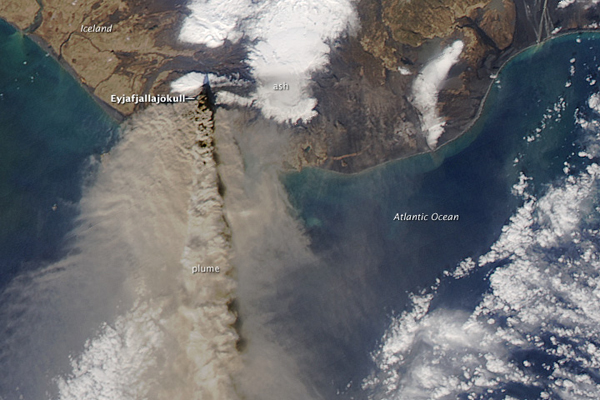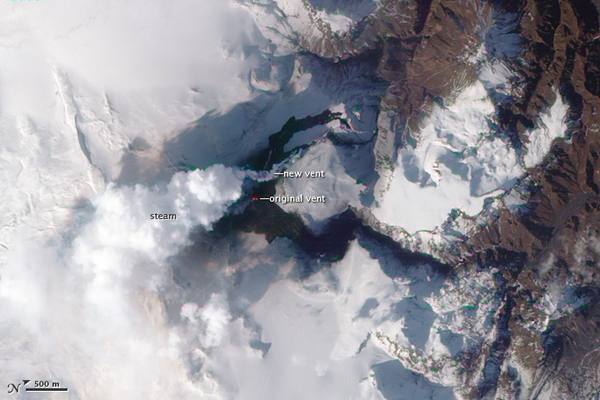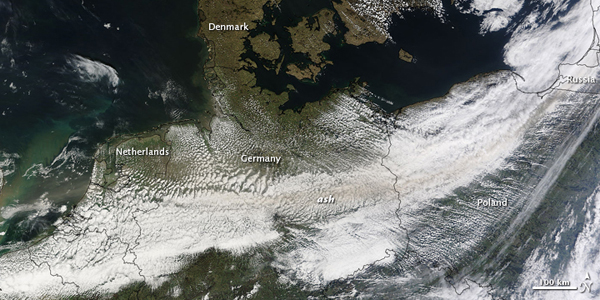
by Carolyn Gramling Thursday, January 5, 2012

Eruption on April 17. NASA image by Jeff Schmaltz, MODIS Rapid Response Team

Eruption of Eyjafjalla volcano on April 1. NASA image by Robert Simmon, using ALI data from the EO-1 team

Ash from the April eruption covered much of Northern Europe. NASA image courtesy Jeff Schmaltz, MODIS Rapid Response Team at NASA GSFC
When an Icelandic volcano with a nearly unpronounceable name erupted after 200 years of quiet in March, it was little more than a curiosity. But when it erupted again in April — this time spewing huge clouds of ash as high as 11 kilometers into the stratosphere, quickly choking airways across Europe and costing airlines billions of dollars — it captured the world’s attention. As the ashfall decreased and airlines resumed normal routes this week, the headlines began to fade. But scientists are only beginning to piece together the unusual combination of forces behind Eyjafjalla volcano’s powerfully explosive eruption.
Iceland has always had a fiery geological history. It sits directly atop the Mid-Atlantic Ridge, where two crustal plates, the Eurasian and the North American plates, are diverging. The jagged line of the main spreading ridge runs straight through the country, while a second spreading ridge branches off toward the southeast. The traces of these spreading ridges are marked by numerous volcanoes, including the southeastern volcanic zone, home to currently erupting Eyjafjalla volcano (often called Eyjafjallajökull; jökull refers to the glacier that sits atop the volcano) and periodically active powerhouses Katla and Hekla. And the spreading ridges aren’t the only source of volcanic activity: The country is also positioned over a plume of hot rock that originates deep in the mantle. These tectonic forces are slowly pulling the country apart.
There is also, of course, abundant ice. Eyjafjallajökull is now famous, but many other glaciers in the region also mask fiery volcanic craters.
Both fire and ice played a role in producing the ash clouds that first erupted in March and then more persistently and powerfully in April, say scientists with the Nordic Volcanological Center (NVC) in Reykjavik, Iceland. Preliminary analyses of the chemical makeup of the tephra, or ashfall, in March and April are beginning to sketch out the story of an evolving volcano, says NVC geochemist Olgeir Sigmarsson.
Eyjafjalla volcano has not erupted since 1823, but has shown unrest from time to time, including periods in 1994, 1999 and 2009. NVC at times noted GPS-measured surface deformation — a common sign of magma on the move. Then, in early March this year, the magma again showed signs of movement. NVC began to record high rates of deformation and intense seismicity deep below the volcano, 25 kilometers below the surface, pointing to a deep source of magma.
Shortly before the March eruption, the seismicity shallowed. A fissure on the volcano’s east flank erupted March 21, Hawaiian-style, with flowing fiery lava and a small plume of ash. Although a minor eruption, it was interesting from a geochemical standpoint: This volcano didn’t normally erupt this type of magma. The magma was, in geological terms, “primitive” — meaning it resembles the chemical makeup of the mantle. “It is very rare that you see such primitive magma,” rather than a much shallower magma chamber feeding the volcano, Sigmarsson says. “It was quite interesting.”
Then it got more interesting. The seismic signals migrated toward the central crater of the volcano. They became tremors. In April, the volcano burst again. And this time, the eruption was of a very different character: It produced huge clouds of ash, and lava with a very different chemistry.
The volcanoes that occur along mid-ocean ridges tend to erupt basaltic magma, a relatively dense magma that makes up most of the ocean’s crust. Basaltic eruptions don’t tend to be explosive because they don’t contain many dissolved gases. But magma rising slowly to the surface can evolve over time — as it cools, crystals form and settle out of the molten liquid, leaving a changed chemical composition behind. Such crystal fractionation makes the magma richer in silica, more viscous and more likely to contain dissolved gases. Silicic eruptions, therefore, can be considerably more explosive than the basaltic kind.
Eyjafjalla has only erupted three times in recorded history, Sigmarsson says — and each time, it was relatively silicic. The last eruption lasted, on and off, for about three years, from 1821 to 1823. The lava erupted during that event had a kind of intermediate chemical composition called a trachydacite.
So when geologists began to study the chemical composition of the ash from the current eruption — which also offers insight into the chemical composition of the magma beneath the volcano — they found something interesting. Plotting a range of chemical compositions — ash from the March eruption, the April eruption, the 1821 eruption and from nearby Katla, which last erupted in 1918 — they discovered that the powerful ash bursts from April looked exactly like a chemical mixture of Katla ash and the 1821 ash.
That tells a certain story, Sigmarsson says. While the March eruption may have been fed from a deep mantle source, he says, the magma driving the April eruption came from a different place: a mix of much shallower, more viscous and more explosive magmas.
Silicic magma has “a kind of inherent explosivity, a lot of dissolved gas,” Sigmarsson says. But that wasn’t the only factor at play in producing the large ash cloud that brought Northern European airspace to a halt: There was a second boiling effect, related to the multiple magma sources beneath the volcano, he adds. When hot basaltic magma encounters a cooling silicic body, it heats the magma up again — and any dissolved gases still in the magma also heat and expand, creating a more explosive situation. Then there’s the steam. Eyjafjalla is a subglacial volcano; when water from a melting glacier mixes with hot magma, the resulting steam can pack an explosive punch.
It’s not actually surprising that Eyjafjalla volcano is erupting silicic magma — although perhaps counterintuitive, since it’s near a mid-ocean ridge, says Katryn Wiese, chair of the earth sciences department at the City College of San Francisco. Wiese, who wrote her dissertation on Eyjafjall volcano, says that just to the north is another explosive (but not subglacial) volcano named Hekla. Hekla has also erupted silicic lavas in the past, she says, including during its most recent eruption in 2000. (In January, scientists noted that the volcano was showing signs that the pressure in its lava chamber has again increased to its last pre-eruption levels.) The silicic magmas erupted at Hekla and Eyjafjalla volcano likely form due to similar crystal fractionation processes, she adds.
Although Eyjafjalla is the volcano of note at the moment, its “sister” Katla is the volcano on many people’s minds. Katla is more of a fraternal twin: Although it is also subglacial, its magma is basalt, and doesn’t look anything like that of the volcano with the longer, more unpronounceable name. However, they do seem to be related somehow: All of Eyjafjalla volcano’s historical eruptions — except for the current one, so far — occurred in close timing to a Katla eruption (although Katla has erupted many times as a solo act). Whether Katla or Eyjafjalla were the first to erupt in each of those cases, however, is not clear, Sigmarsson says.
There are currently no signs of unrest at Katla, but scientists are keeping a close watch, he adds. Katla is considered one of Iceland’s most dangerous volcanoes; its most recent eruption almost 100 years ago produced a devastating glacial outburst flood, in which meltwater, ash, mud and ice rushed down the flanks of the volcano, covering the surrounding countryside.
© 2008-2021. All rights reserved. Any copying, redistribution or retransmission of any of the contents of this service without the expressed written permission of the American Geosciences Institute is expressly prohibited. Click here for all copyright requests.